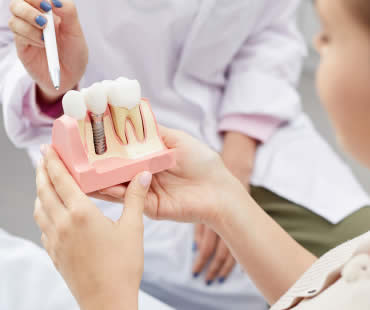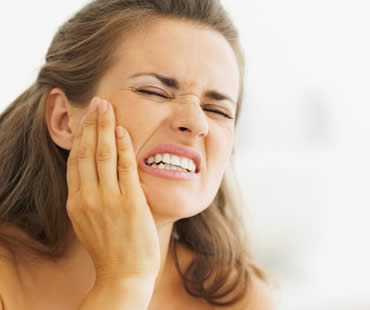
Replacing a Tooth with a Dental Implant
The Importance of Dental Health
A healthy mouth is essential for overall health and well-being. Oral health problems, such as gum disease and tooth decay, can lead to serious health issues if left untreated. Poor dental hygiene can also result in social and psychological consequences, like bad breath and low self-esteem.
An Overview of Tooth Replacement Options
Tooth loss can happen due to various reasons like trauma, tooth decay, or periodontal disease. Fortunately, there are several options available for replacing missing teeth including dentures, bridges, and dental implants. Each option has its advantages and disadvantages based on the patient’s specific needs.
Focus on Dental Implants
Dental implants are a popular solution for those who require a permanent tooth replacement. A dental implant is a post that is surgically placed into the jawbone to act as an artificial root for the replacement tooth. The implant fuses with the jawbone in a process called osseointegration, which provides strong support for the new tooth.
Dental implants are versatile options that can replace a single missing tooth or even entire arches of teeth. The rest of this article will focus on dental implant methodology discussing what they are exactly; how they work; what the benefits are; potential risks involved; aftercare instructions to follow during recovery process; insurance coverage applicable to it along with costing factors affecting its price etc..
What is a Dental Implant?
Dental implants are artificial tooth roots that provide a permanent base for fixed or removable replacement teeth. They serve as an alternative to dentures, bridges, and other tooth replacement options.
Dental implants are made of titanium and other materials that are compatible with the human body. The implant itself is surgically placed into the jawbone where it fuses with the bone tissue in a process called osseointegration.
Components of a Dental Implant
The dental implant consists of three parts: the implant, abutment, and crown. The first component is the implant which serves as the artificial root of the tooth replacement. It is made of titanium or similar material that fuses with jawbone tissues in a process known as osseointegration.
The second component is an abutment which connects to the implant and protrudes above gum line for mounting an artificial crown or prosthetic tooth on top of it. The final component is a crown which serves as an external aesthetic layer for the dental implant.
Advantages over Other Tooth Replacement Options
Dental implants offer numerous advantages over other tooth replacement options such as dentures and bridges. Firstly, they look and feel just like natural teeth, providing greater self-confidence when speaking, eating or smiling.
Secondly, they do not require any adhesives or special cleaning methods since they are permanently anchored into your mouth via osseointegration hence easy to maintain hygiene e.g brushing and flossing like normal teeth.. Thirdly, dental implants can last a lifetime while dentures may need frequent adjustment due to wear over time causing discomfort to wearer’s gums . , unlike traditional bridges which require altering adjacent healthy teeth in order to support them , dental implants do not affect adjacent healthy teeth since it functions independent from them making it more prefered by patients who wants to keep their healthy teeth intact.
The Dental Implant Procedure
Evaluation and Planning
Before the dental implant procedure, an evaluation of the patient’s oral health is necessary. This involves examining the teeth, gums, and jawbone with x-rays and scans to determine whether the patient has enough bone density to support an implant.
In some cases, a bone graft may be necessary to strengthen the jawbone. The dentist will consider factors such as age, lifestyle habits, and medical history before proceeding with the implant procedure.
Placement of the Implant
Once evaluation and planning are complete, placement of the dental implant can begin. First, a small incision is made in the gum tissue where the tooth is missing.
Then, a hole is drilled into the jawbone where it will act as an anchor for the implant screw. The screw is then inserted into place using specialized tools designed for precise placement.
Osseointegration Process
The osseointegration process refers to how an implanted fixture integrates with surrounding bone tissue over time. This process can take several months to complete and involves new bone growth around and through tiny holes in the surface of each dental implant post or screw. During this process, patients must maintain healthy oral hygiene habits by brushing twice per day and flossing daily.
Attaching The Abutment And Crown
After osseointegration has occurred successfully — meaning that there has been significant adhesion between your gums or bone tissue to your implants — you will need an “abutment” attachment placed atop each implant post so that it can hold a crown or other prosthetic device securely in place within your mouth. Once these abutments have been attached by your dentist (usually two weeks after placement), impressions are taken of your mouth so that custom-made crowns can be created accordingly, which are then quickly secured to the abutments using dental cement.
Overall, the dental implant procedure can take several months to complete, but it is a long-term solution for replacing missing teeth that provides many benefits over traditional dentures or bridges. Consult with a qualified dental professional today to learn more about whether dental implants are right for you.
Recovery and Aftercare
After receiving a dental implant, it is important to follow your dentist’s post-operative care instructions carefully. Proper care and maintenance will help to ensure that the implant heals properly and functions as intended.
Post-operative care instructions
Your dentist may provide you with detailed instructions on how to care for your dental implant after the procedure. Some common post-operative care instructions include:
- Avoiding hard or crunchy foods for a few days after the procedure
- Maintaining good oral hygiene habits, including brushing and flossing every day
- Rinsing your mouth with warm salt water several times a day to reduce swelling and promote healing
- Avoiding smoking or using tobacco products, which can slow down the healing process
Pain management techniques
You may experience some discomfort or pain after receiving a dental implant. Your dentist may recommend pain management techniques such as over-the-counter pain medication or prescription medication.
In addition to medication, there are other pain management techniques you can try, including:
- Using an ice pack on your cheek near the implant site to reduce swelling and numb any discomfort
- Eating soft foods that are easy to chew until any soreness subsides
- Avoiding strenuous physical activity that could exacerbate any discomfort in the area around the implant site.
Follow-up appointments
After receiving a dental implant, it is important to schedule regular follow-up appointments with your dentist. These appointments will allow your dentist to monitor the healing process of your implant and make any necessary adjustments. During your follow-up appointments, your dentist may take X-rays to ensure that the implant is healing properly and fusing with the jawbone.
Your dentist may also examine the implant site for any signs of infection or other complications. It is important to attend all scheduled follow-up appointments and to contact your dentist if you experience any issues or concerns regarding your dental implant.
Benefits of Dental Implants
Improved oral health
Dental implants can improve your oral health in several ways. Since they are inserted into the jawbone, they stimulate bone growth and prevent bone loss.
This helps to maintain the structure of your face and prevent sagging or sunken cheeks. Additionally, a dental implant doesn’t rely on adjacent teeth for support, as a bridge would, so it doesn’t put additional strain on them or increase the risk of decay.
Restored chewing ability
When you have missing teeth, it can be difficult to chew properly and enjoy certain foods. Dental implants provide a natural-feeling replacement for missing teeth that allows you to eat anything you want without worrying about discomfort or difficulty chewing. Plus, since they are anchored in place just like natural teeth, you won’t have to worry about them slipping out of place while you eat.
Enhanced appearance and self-confidence
Missing teeth can have a major impact on your appearance and self-confidence. When you get dental implants to replace missing teeth, you’ll be able to smile confidently knowing that your replacement teeth look and feel just like natural teeth. With dental implants in place, there won’t be any gaps in your smile or visible metal clasps like there might be with other tooth replacement options.
Dental implants offer several benefits beyond simply replacing missing teeth. They support good oral health by promoting bone growth in the jawbone and reducing strain on adjacent teeth.
They also restore full chewing ability so that you can enjoy all your favorite foods without any discomfort or embarrassment. And with their natural-looking appearance, dental implants can boost confidence by giving patients their radiant smiles back again!
Costs and Insurance Coverage for Dental Implants
Factors affecting cost
The actual cost of a dental implant can vary based on several factors such as the number of teeth being replaced, the complexity of the procedure, the location of your dental practice and even the type of implant used. Other significant aspects that influence cost include additional treatments like bone grafting or extractions.
In general, however, dental implants are slightly more expensive than other forms of tooth replacement procedures like dentures or bridges. However, it is important to note that they come with significant benefits that make them an investment in long-term oral health.
Insurance coverage for dental implants
Most dental insurance policies don’t cover the full cost of a dental implant procedure but, depending on your plan and type of treatment needed, some portions may still be covered. It is essential to check with your insurance provider before beginning any treatment to verify what will be covered under your specific plan.
While not all insurance policies pay for implants or treatments surrounding them directly, some plans may cover parts such as tooth extraction or bone grafting costs that are related to the procedure. In addition to traditional insurance plans, there are alternative options available for patients who need assistance covering costs associated with a dental implant procedure.
Some healthcare credit providers offer financing options specifically designed for medical expenses like these procedures and can allow patients in need to make manageable monthly payments rather than pay everything upfront. Regardless of how you’re planning on financing your treatment or how much it costs ultimately; a dental implant is an investment in long-term oral health and general well-being that’s worth considering if you’re missing one or more teeth.
Why Choose a Dental Implant?
Benefits over other tooth replacement options
After analyzing the various options for replacing a missing tooth, it is clear that dental implants offer the most advantages. Unlike dentures and bridges, dental implants are a long-term solution.
They do not require any special care beyond good oral hygiene and regular check-ups with your dentist. Additionally, dental implants help preserve the integrity of surrounding teeth and prevent bone loss in the jaw.
Importance of Consulting
It is important to consult with an experienced dentist to determine if dental implants are right for you. Your dentist will evaluate the condition of your mouth and take into consideration factors like your overall health, jawbone density, and gum health. They will also discuss any potential risks or complications associated with the procedure.
By consulting with a professional, you can make an informed decision about whether or not to proceed with dental implant surgery. While there are several tooth replacement options available in modern dentistry, dental implants stand out as the best choice for those looking for a permanent solution that looks and functions like natural teeth.
With proper care and regular follow-up visits with your dentist, dental implants can last for decades to come. If you’re considering this procedure, schedule a consultation with an experienced dentist to learn more about how it can benefit your oral health and well-being.
We treat patients from Gaithersburg and the surrounding area





